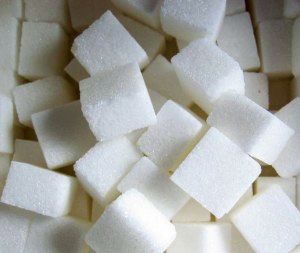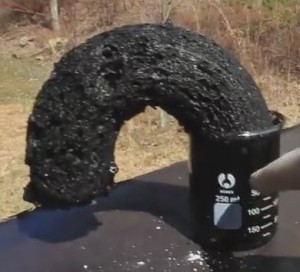 Sugar is white. Sulfuric acid is colorless. So how is it sulfuric acid turns sugar black? Table sugar is actually two sugars in one—a disaccharide. It is commonly known as sucrose.
Sugar is white. Sulfuric acid is colorless. So how is it sulfuric acid turns sugar black? Table sugar is actually two sugars in one—a disaccharide. It is commonly known as sucrose.
Sucrose is a combination of fructose, a sugar found in fruits, and glucose, known also as blood-sugar, grape-sugar, and corn-sugar. Its chemical formula is C₁₂H₂₂O₁₁.
The way these atoms are attached to each other by chemical bonds determines its structural formula.
In the Left Corner…
Most sugar from a grocery store is granular and pure white. If the grains are large enough—existing as large crystals—it is immediately apparent that sugar isn’t even white; it is totally colorless and transparent. Sold at candy stores, we call it rock candy.
In the Right Corner…
Concentrated sulfuric acid is thick and nearly colorless—oily—much like the Karo Syrup one puts on pancakes. It is an extremely dangerous acid and dehydrating agent, capable of inflicting severe burns. One of my college chums, working in a laboratory during a work-cooperative assignment, caught just the bottom of a large bottle of the stuff on a laboratory bench. It landed on his blue-jeans. In just seconds he was under a safety shower. Yet, he suffered 3rd-degree burns!

Let the Fight Begin!
Pour some concentrated sulfuric acid¹ into a beaker containing sugar granules, and a dramatic reaction takes place.² The sugar turns brown, then changes to black. The volume of the sugar increases greatly. What happened? What’s the black stuff and what is the mist? Why is the beaker so hot?
Knockout: What Happened?
The heat is due to the release of a tremendous amount of energy. All that heat vaporizes water producing steam—the mist is mostly water.³ Be careful to avoid the mist, as it doubtless contains traces of acid. Did you notice from the structural formula of sucrose that it contains atoms of hydrogen and oxygen? Combine them, and you get the water, formula H₂O.
Just one molecule of sucrose contains 11 molecules of water. If you take those out, all that remains of a sugar molecule are 12 atoms of carbon. The black residue is mostly carbon with some excess acid.
Sulfuric Acid Turns Sugar Black
Sulfuric acid is a super-strong dehydrating agent, it sucks up water, or the components needed to produce it. Hence, the ether groups (-C-O-C-) and hydroxyl groups (-OH) in sucrose are stripped away. The overall reaction is written:
C₁₂H₂₂O₁₁ → 11 H₂O↑ + 12 C
Turned to colorless water and black carbon, the sulfuric acid turns sugar black.
¹ The sulfuric acid needs to be concentrated to exert its dehydrating effect on sugar.
² This reaction should not be attempted, except by properly-trained laboratory personnel.
³ Carefully avoid contacting the mist. It is mostly steam, but may well contain traces of acid.
Enjoy the following video. Not that all fumes are being blown away from the participants, and do not do this at home.
Note: You might also enjoy Nitrogen Tri-Iodide: Schoolboy Explosive?
References:

Amazing.
Good picture to turn anyone off eating sugar!
But why would anyone want to do this ?
What is the purpose of making this mixture of sugar with sulphuric acid?
That’s a good question, Sherry. Probably to demonstrate the dehydrating power of concentrated sulfuric acid as well as the composition of sugar in terms of its elements. Ultimately, sugar is simply a combination of carbon and water.
But what is the purpose?
The only purpose was the instruction of high school chemistry students, doubtless for the reasons I have mentioned.
I think my questions and your answers passed each other. OK. So there really isn’t a desired product produced nor a valuable purpose. Thank you for your answer. I appreciate it.
Exactly. I don’t think anyone would care to dilute sulfuric acid in such a fashion, or obtain elemental carbon through such a dangerous process. Besides, the carbon would be thoroughly contaminated with acid! My pleasure. Thanks for your visit.
If reconstituted with sodium bicarbonate mixed into water one could easily nullify the acid. However I do not know if that would leave a useful source of carbon say for a blacksmith, something I need to try I guess.
Buy the carbon. It’s a whole lot cheaper.
Thank you for the video my 11 year old is doing a project on battery acid this was great to see the acids reaction. He loved it thanks!
That’s great.
There’s a beautiful form of precious opal from Australia that consists of colorful flecks of opal in a porous, light colored matrix. The stone is soaked for several days in a heated sugar solution and then placed in a container of sulfuric acid. This carbonizing reaction blackens the stone, blackening the sugar trapped in the pores, but doesn’t affect the opal. The result is that the contrast of the gemstone is increased and the opal shines brightly, no longer washed out by the light reflecting from the previously pale stone.
Cool!